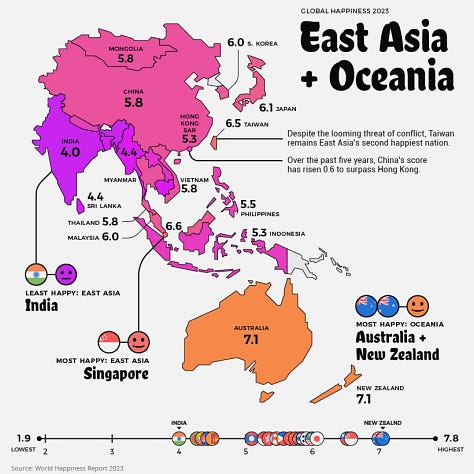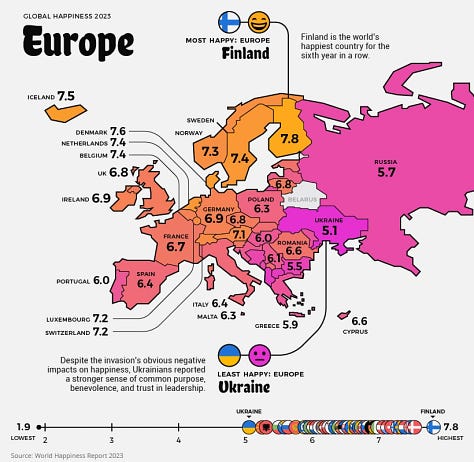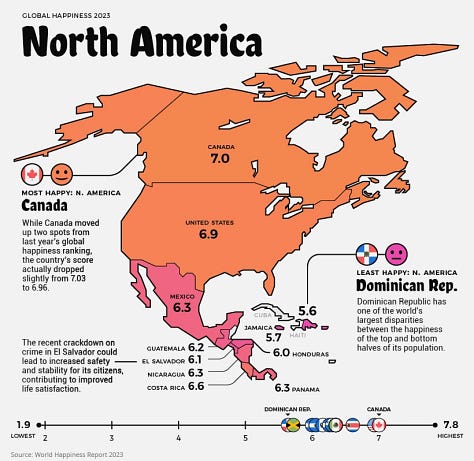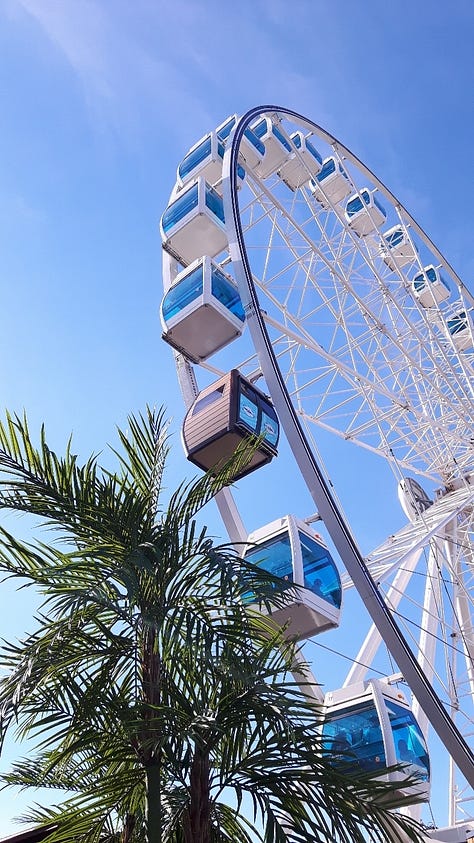The Happiest Place On Earth 📰
The 2023 World's Happiest Country has a lot of dark days and a 65% tax rate! (📰Map News)
Hi! If you’re new here, this is Map Nerd. We explore amazing places and cool things on the world map, usually with a video story + quick digestible info. If you enjoy it, subscribe and you can explore with us!
In this edition:
Trying out new format!
Maps In News & News On Maps
Good Map 😍 / 🙄 Bad Map
This Week’s Video: The Happiest Place on Earth
Ranking The Happiest Countries: About The World Happiness Report
How We Measure Happiness: The Cantril Scale
FYI the last sections may get cut off in your inbox - click “view entire message.”
Trying out new format!
My sincerest apologies for the delay in getting this next edition of the Map Nerd newsletter out to you. I’ve been working on trying some new things out. So, you’ll notice there’s been some change-ups in this edition:
I added two new sections to the top that I hope you’ll enjoy:
Maps In News & News On Maps: hand-picked latest news with fun, interesting, and relevant maps and/or map-related content. Mostly this will be quick links to interesting geography stuff that you can procrastinate with.
Good Map 😍 / 🙄 Bad Map: here I’ll share one beautiful, awesome, fascinating, cool, add-any-other-positive-adjective-here, map AND one not so great, trending towards absolutely terrible, map. Hopefully you’ll be mesmerized by something super interesting and then be able to laugh at something absurd.
After those, I’ll present This Week’s Video and other interesting related topics, as you’ve come to love and expect from the Map Nerd newsletter (hoping for love, but I’ll take expect :).
Let me know what you think of the new sections. Love to hear your thoughts anytime! Enjoy!….
Maps In News & News On Maps
Here’s a quick selection of interesting map-related topics in recent news for your viewing pleasure:
New Mars Map Stitched Together From 3000 Spacecraft Photos (NYT): UAE scientists gathered a huge amount of photos taken from their Hope spacecraft which has been orbiting around the red planet for the last 2 years. It’s one of the only complete images of the whole planet of Mars.
Brand New Australian City is Under Construction: Sydney’s new planned urban center Bradfield City has broken ground and is being built from scratch with high ambitions.
The World’s Busiest Airports: another fun list that was released recently. And I made a quick video on it too!:
Time Out Ranks Top Cities with Best Public Transport In The World
The Pandemic Didn’t Upend US Geography (Bloomberg CityLab): CityLab dives into the real stats behind migration patterns before and after the pandemic. Conclusion: fears of an urban exodus are overblown.
Plans For a Real-Life Snowpiercer Train?: The InterContinental Railway is a proposed rail route linking Paris to New York, via Russia. It’s far-flung, but fun to think about (plus this latest article on it is from one of my favorite map writers Frank Jacobs).
Good Map 😍 / 🙄 Bad Map
😍The Good Map: Since this week is all about the World Happiness Report, this good map visualizes the world happiness rankings in what I think is a pretty style that’s easy to understand and fun to navigate. Well done, Visual Capitalist (they specialize in making maps & infographics based on news & current events: visualcapitalist.com)







🙄The Bad Map: In researching for this story, I went deep looking into Finland’s national obsession with saunas. I came across photos and stories of saunas of all types, from ultra-modern architectural masterpieces to one in Burger King (that’s true - photo of it in section below). But I also found this map which purports to show “All The Public Saunas In Finland.” Putting aside whether or not it actually marks all the public saunas in Finland (which is a tall task considering how many there are), this is a terrible map. There’s no good information that can be extracted from this other than “there’s a sh*t ton of saunas in Finland.”

This Week’s Video:
The Happiest Place On Earth 2023
The happiest country in the world has up to 7 months of winter, a few hours of daylight, and a tax rate as high as 65%.
That may not sound like a winning combination for everyone, but it is for Finland, which was named the happiest country in the world for the sixth year in a row!
The 2023 World Happiness Report was released last month. The annual reports asks 1000 people in each of 137 countries to rank how they feel about their life (they do that via the Gallup World Poll which uses a particular type of question to measure life satisfaction called the Cantril Scale - more about how that question’s asked in a later section below).


Finnish people feel pretty good. Better than anyone else, by a wide margin.
So what makes the people of Finland so annoyingly happy?
I read the report so you don’t have to (not that you had to).
Finland’s got a lot of things that experts think help, like:
1. Sisu: everyone mentions Sisu when talking about this report. It’s a uniquely Finnish concept that admires grit, determination, and resilience. It’s every Finn’s inner strength to push through the worst odds. Finn’s take great pride in their sisu.
2. The Right to Roam: In Finland, everyone can hike, bike, fish, sail, or ski pretty much anywhere that isn’t too close to a house, regardless if its private land. As long as you respect it, you can use it.
Link: Read More on Everyman’s Rights / Jokamiehen Oikeudet (Visit Finland)
3. Saunas: Most Finns have a sauna or two. In a population of 5.5 million, there are over 3 million saunas and most Finns take a sauna at least once a week. Besides getting sweaty, saunas are shown to improve physical and mental health in as lot of ways.



4. Free/Universal Healthcare and Education. Part of those high taxes go to a robust universal healthcare system and free school for everyone through university.
5. Generosity & Equality: schools and healthcare go a long way to providing a somewhat level playing field for the majority of people. On top of that, there is a national pension system that is available to everyone, not just those that pay into it. There’s also a housing first policy which gives the homeless permanent housing before they secure a job.
Link: Overview of Finnish Pensions (Finnish Centre For Pensions)
6. Trust: Finns trust each other, they very rarely lie, more than 80% trust the police and some of their prisons are open: no gates, no locks, and guess what? Inmates are less likely to re-offend!
Link: What I Learned from visiting Finland’s Open Prisons (Chicago Sun-Times)
Video: These Prisoners Have Their Own Keys (NBC News) - Watch Below
These qualities correlate well with 6 main factors that the authors call out as the main drivers behind the average person’s perception of happiness. They are:
Income ().
Social Support (having someone to lean on).
Health (mental health being most important).
Freedom to make your own choices.
Generosity (helping others).
The Absence of Corruption.
To be clear, it’s not all perfect and Finland’s not the only country to have a lot of these things (the other Nordic countries share similar concepts, which is why it’s not surprising they’re all ranked in Top 10 - More on the complete happiness list in section below).
But, the thing I heard the most about why Finland is the world’s happiest country is surprisingly that it’s really not that happy.
Not in an all-smiles bright cheery sort of way. If you know someone from Finland chances are you’re aware that they’re not always smiling. They don’t expect life to be perfect, try to enjoy it when its pretty good, and have support to lean on when it’s not.
In fact, understanding you don’t have to be all smiles all the time to be happy is kind of the point.
Ranking The Happiest Countries In The World:
About The World Happiness Report
The World Happiness Report has compiled a list of the world’s happiest countries since 2012. Rather than being a study in of itself, it actually relies on data from external polls and studies (the most important being the Gallup World Poll which is conducted annually by Gallup).
The Report analyzes the data and attempts to formulate hypotheses about why certain places may be more happy than others, and provide suggestions on tactics to improve overall global happiness. To be sure, there is a scientific approach to the analysis: things like data models and regression analysis are used to find correlations between the happiest places and factors that may make them so. However, it’s also not completely free of bias: it’s published by the Sustainable Development Solutions Network, which is an organization that evolved out of the UN’s sustainable development initiative. So, many of the happiness-affecting factors and solutions raised are within a sustainable development framework (which I’m not suggesting is bad, only that if you’re going to read it, it’s good to know the context going in).
The happiness rankings are solely determined by responses to the Gallup World Poll Cantril Scale question (more on that below). But, that Poll also asks questions relating to different facets of life, and the authors of the World Happiness Report highlight the greatest correlations between a Cantril Scale response and a consistent theme on other life factors, such as income, friendships, and trust in government.
Here’s the Top and Bottom of this year’s rankings, plus some of the more interesting maps and graphs in the report. If these prove to be more enticing than you thought, link to the full report is at the bottom!
Top and Bottom of the Rankings…
Relationship Between Generosity & Well-being. There’s a strong correlation between generosity and happiness. It’s clear that giving and receiving support helps makes us humans feel better. That’s a main reason that the authors think overall happiness did not decline due to the pandemic as significantly as theorized. In general, people came together, helped one another, and strengthened bonds within their communities because of the pandemic. Many places saw a noticeable increase in generosity, altruism, and benevolence, which helped to offset the expected precipitous decline in happiness…
Using Twitter to Rate Life Satisfaction. This is a fun one. There is an entire chapter in the report dedicated to social media. Since platforms like Twitter and Facebook are so ubiquitous and consistently updating with the trends, thoughts, and feelings of the population, the report looks at methods of using social media data to assess happiness. The below map shows “life satisfaction” by county in the USA, as measured by analyzing sentiment on Twitter. How do they do that? I can’t tell you if the formula is sound, but the basic idea is they use computers to analyze the prevalence of language and words that associate with well-being…
Download The World Happiness Report 2023 Below:
How We Measure Happiness:
The Cantril Scale
The single most important tool to ranking world happiness for this report, and for a significant chunk of similar type studies, is the Cantril Scale, aka Cantril Ladder. It has been researchers’ go-to method for determining a person’s “true” well-being for the last 50 years. I’m not sure why, in a time when science has been evolving at warp speed (relative to the rest of history), the Cantril Scale hasn’t yet been taken over by some newer, shinier method, but for now it’s still the reigning champ to test if your smile is real.
This is how it works (i’ve taken this direct from Gallup’s site so I don’t jumble the jargon):
Please imagine a ladder with steps numbered from zero at the bottom to 10 at the top.
The top of the ladder represents the best possible life for you and the bottom of the ladder represents the worst possible life for you.
On which step of the ladder would you say you personally feel you stand at this time? (ladder-present)
On which step do you think you will stand about five years from now? (ladder-future)
The Cantril Scale is self-anchoring. It’s entirely up to each individual to determine what each of the 10 steps of the ladder mean to them, and where they see themselves on it. For example, no one suggests that the bottom steps equate to low income. There may end up being a high correlation between lower steps and low income, but no one is given any criteria about where they should place themselves, based on income or anything else, when they are asked.
The Cantril Scale also asks for both present (now) and future (five years from now) perceptions of well-being. The goal in doing so is to “even out” responses to account for a person’s current emotional state. We all have good days and bad days, and daily fluctuations to our mood. Asking a person how they feel about their life on a particularly bad day might get a particularly bad response. Asking how they might feel five years from now can help mitigate that tricky variable. Also, an unhappy person who sees a near bright future is considered to have better well-being than an unhappy person with an unhappy future.
There’s a general consensus that while everyone’s responses are unique, self-anchored, and relative, most people’s thoughts on well-being can be categorized into one of three groupings:
THRIVING: responses that hit around 7+
STRUGGLING: responses around 5-7
SUFFERING: responses 4 and below















